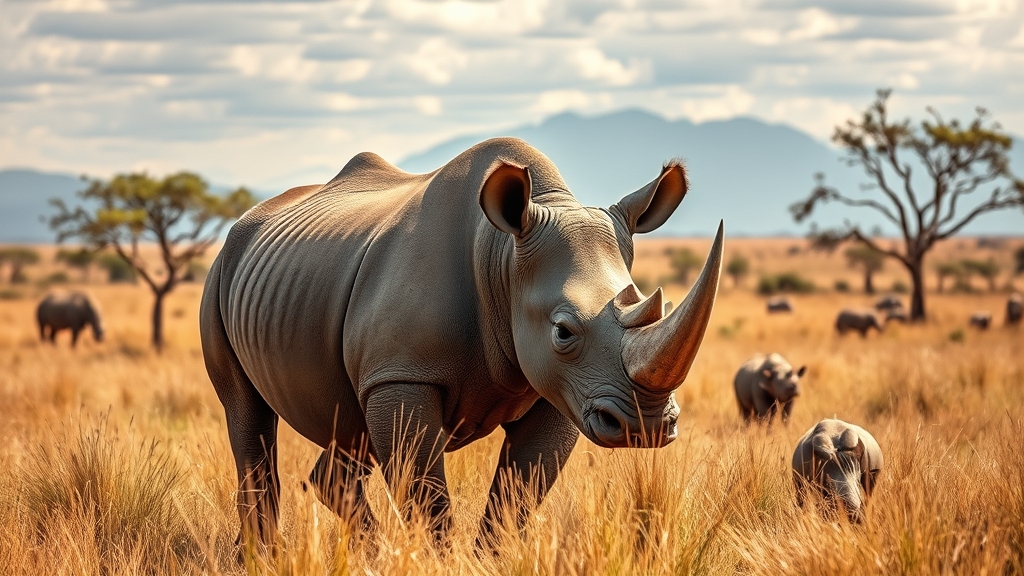You can see that rhinos are remarkably resilient, despite facing serious threats like poaching and habitat loss across Africa and Asia. Conservation efforts focus on protecting habitats, establishing reserves, and involving local communities to fight illegal trade and support rhino populations. Techniques like drone monitoring, patrols, and community engagement help combat poaching and improve survival chances. To understand how these strategies are making a difference, stay with us to learn more about their ongoing fight for survival.
Key Takeaways
- Rhino populations face threats like poaching and habitat loss, pushing them toward extinction despite their resilience.
- Habitat conservation and ecosystem preservation are vital for supporting rhino survival and enhancing their resilience.
- African and Asian conservation initiatives focus on protected areas, wildlife corridors, and community involvement to combat threats.
- Advanced tools such as patrols, surveillance cameras, and drones help detect and deter illegal poaching activities.
- Global collaboration and effective conservation strategies are crucial for ensuring rhinos’ future and their continued resilience.

Have you ever wondered what makes the rhinoceros one of the most resilient animals on Earth? Despite facing numerous threats, rhinos have managed to survive against the odds, thanks to their incredible adaptability and the efforts of conservationists. One of the biggest challenges they face is poaching threats, driven largely by illegal wildlife trade and high demand for rhino horns. Poachers often target these majestic creatures, risking their lives and pushing rhino populations to the brink of extinction. But it’s not just poaching you should be aware of—habitat conservation plays a essential role in their survival. As human populations expand, natural habitats shrink, forcing rhinos into smaller, more fragmented areas that make them vulnerable to poaching and other dangers. Conservation efforts focus heavily on protecting these habitats, guaranteeing that rhinos have space to roam, breed, and sustain their populations naturally. When their habitats are preserved and restored, rhinos are better equipped to withstand poaching threats and adapt to their changing environments. Additionally, maintaining healthy marine and dune ecosystems can help buffer coastal areas from erosion and climate change impacts that threaten inland habitats. It is also crucial to recognize that airtight enclosures are not typically used in the wild, but effective protection methods are essential for their safety. When their habitats are preserved and restored, rhinos are better equipped to withstand poaching threats and adapt to their changing environments.
In Africa and Asia, where most rhino populations are concentrated, habitat conservation initiatives have become indispensable. Protected areas, national parks, and wildlife corridors are established to reduce human-wildlife conflict and provide safe zones for rhinos. These efforts often involve local communities, who are included in conservation plans to foster a sense of shared responsibility. When communities see the benefits of maintaining healthy ecosystems, they’re more likely to support conservation initiatives and help curb poaching activities. Technology also plays a role: ranger patrols, surveillance cameras, and drone monitoring are used to track rhino movements and detect illegal activity early. These measures serve as a deterrent to poachers, making it harder for them to succeed.
Despite the ongoing threats, rhinos showcase resilience through their ability to adapt and recover when given the right protection. Every successful habitat conservation project adds to their chances of survival. It’s a shared responsibility—government agencies, local communities, and global organizations must work together to combat poaching threats and preserve the habitats that sustain these incredible animals. If we act now, we can guarantee that future generations will still witness the resilience of the rhinoceros, a symbol of strength and survival amidst adversity. The journey isn’t over, but with continued dedication and effective conservation strategies, rhinos can continue to thrive in their natural environments.
Frequently Asked Questions
How Do Rhino Horns Develop Biologically?
You might wonder how horn growth occurs in rhinos. During biological development, a rhino’s horn starts as a keratinous structure, growing from specialized cells at the base. As the rhino matures, the horn continuously adds keratin layers, making it thicker and longer. Unlike bone, the horn’s growth depends on the animal’s health and age, and it doesn’t have a bony core, allowing for rapid regeneration and shaping.
What Traditional Medicines Use Rhino Horns Globally?
Imagine entire mountains of rhino horns stacked high, used in traditional medicines across the globe. You see, cultural beliefs fuel the demand, believing they cure everything from fevers to cancer. This illegal trade devastates rhino populations, turning them into targets of greed and myth. Countries in Asia and Africa still rely on these ancient practices, making rhino horns a symbol of both tradition and peril in the modern world.
Are There Successful Captive Breeding Programs?
You might wonder if captive breeding programs are successful. They can be, especially when focusing on maintaining genetic diversity through careful captive management. These programs aim to boost population numbers and preserve genetic health, increasing the chances of survival for rhinos. While challenges remain, some reserves have seen promising results, with increased birth rates and healthier animals, offering hope for the species’ future.
How Do Local Communities Benefit From Rhino Conservation?
Imagine the power of unity in conservation efforts. By engaging local communities through community engagement and economic incentives, you help protect rhinos while uplifting livelihoods. You benefit from eco-tourism, job opportunities, and sustainable resource management, turning conservation into a shared success. This approach fosters a sense of ownership and pride, ensuring that local people become active guardians of rhinos, securing their survival for future generations.
What Are Future Technological Advances Aiding Rhino Protection?
Future technological advances like genetic engineering could help boost rhino populations by enhancing their resilience and genetic diversity. Anti-poaching drones will become more sophisticated, enabling you to monitor large areas in real-time and respond quickly to threats. These innovations will empower you to protect rhinos more effectively, reducing poaching risks and supporting long-term conservation efforts. Embracing these technologies is vital for securing a future where rhinos thrive.
Conclusion
You’ve seen how the resilient rhino fights for its future, facing fierce threats with unwavering will. By boosting protection, promoting preservation, and strengthening still-standing sanctuaries, you become part of the powerful push to preserve these precious pachyderms. Every effort, no matter how small, supports their survival story. Together, you can champion change, champion conservation, and champion the cause of these courageous creatures, ensuring their resilience endures for generations to come.







